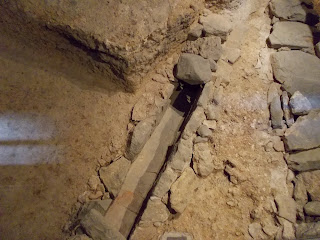What's left of the original Roman city of Barcino lies buried under the current city. Building on top of other structures is nothing new, it's just a shame that there is very little left over from the original city. We took a bunch of pictures, but it was a new camera and it wasn't my good one. I didn't feel like lugging it around the city, we walked everywhere. Some of the pictures are a little blurry but it's neat to look back at life in 1-3AD.
Typical Roman construction including access to the sewer system.
Mosaic from the largest house in Barcino.
Can't remember where this one is from.
Roman sewer system. This type of construction was also used in moving any type of liquid in shops, wineries, etc.
Various pools for the fullonica, the laundry. This was also the dye shop, and a place where urine was collected so the dyes would set into the clothing. Eventually the government realized how valuable urine was so they began to install public urinals and then sold the urine to those who needed it for business.
Fish factory. A lot of salt and a lot of fish gives you some good eating. This shop also made garum, a fermented sauce made from fish intestines. The tanks would hold the finished sauce, this sauce was a daily supplement with meals, mainly for the wealthy.
The large round hole is where the fish sauce would ferment. The square tanks above is where they would stack the fish in layers with salt and a final deep layer of salt. You can see the drainage system from tank to tank for liquid.
Random tablet.
Column work.
Inhabitants who could afford it would have their loved ones last forever in life like carvings.
Tanks from the winery. The locals, including children, drank 1/2 to 1 liter of wine each day.
Tools from the day.
Mosaic from the church, around 3AD.
The church sprung up in the same place as the original Roman town after Constantine the Great converted to Christianity. The higher ups in the church took over the wine and fish factory for the church. I didn't get pictures of it, but you can actually see the construction on top of the original roman buildings, and some incorporation of the passages on the original outer wall.
Eventually the church grew up and became what you see here.
The alter area.
No shortage of amazing design, including the ceilings.
Outside view of the church.
Some fun info:
Roman buildings were designed with a central room and small rooms for sleeping. The roofs of these buildings pointed down and in so the rainwater would collect in pools and gardens for drinking. The wealthier families would have shops on the street side of the house and either sell whatever product they produced or rent the spaces out. Semi wealthy families would have mosaics and sculptures that were visible from the main entrance to all those walking by. The more elaborate the gardens, mosaics and sculptures, the more wealthy they were.
Everyone trying to outdo each other with the latest and greatest. Bigger and better. Sort of reminds me that some things never change.

















My wife and I were stationed in Italy for four years. We enjoyed touring and spent a lot of time in Herculaneum and Pompeii. The best preserved Greek city I saw in Italy was Paestum. It looked like they just walked away and left it.
ReplyDeleteWe have been mulling over going to Italy next year for 10-14 days, but this trip to Spain really turned us off of the idea. Unless we can save up a lot and go first class, can't stand being in the back of the plane on an 8 hour flight.
DeleteIf we end up going, Herculaneum and Pompeii are on the list. I loved finally going to Pompeii... heck over a year ago I think, can't wait to spend more time there.